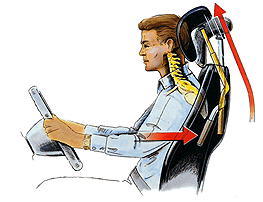
By Eliza Geh
Head Rests

Head Rests
The head rest’s responsibility is to protect your spine and neck during a crash. If a vehicle were to be struck from the rear and pushed forward, the cars seats will push the occupants forward as well. As a result of the physics of the body, the head of the occupant will not be synchronised with the movement of the torso, which can result in the neck bending back and stretching. The head will then suddenly accelerate forwards by the neck, which is called whiplash. A properly constructed and adjusted head rest will limit the damage to the neck.
Drivers with properly adjusted restraints are indicated to have 40% less occurrence of neck pain compared to improperly adjusted head restraints. The initial adjustment is manoeuvring the head rest upward or downward so the mid point of the head restraint meets the central point at the back of the head. The distance between the head and the restraint should not be more than four finger widths
Head Rests and Newton's Laws
Newtons third law of every action has an equal and opposite reaction can be applied to the car safety feature of a heard rest. When a vehicle makes contact with another car from behind, the energy is transferred into the the car in front. The car will then move forwards and a body at rest stays at rest and therefore the head is stationary until the occupants body is lurched forwards with the rest of the car. if the occupants head is against the head rest, the head rest will allow the head to move forward at the same time as the rest of the body and will therefore prevent the occupants head from snapping backwards.
Head Restraints reduce the overall risk of the cars occupants:
